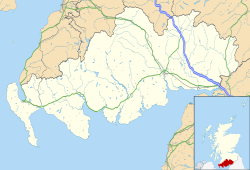| Luce Bay | |
|---|---|
| Scotland | |
 Aerial view of Luce Bay. Looking across the eastern part of Loch Ryan and over Stranraer. In the distance can also be seen the Isle of Man | |
| Site information | |
| Type | Missile Range |
| Owner | QinetiQ |
| Operator | Qinetiq |
| Controlled by | |
| Location | |
Location of Luce Bay within Dumfries and Galloway | |
| Coordinates | 54°50′42″N4°52′07″W / 54.845°N 4.8687°W |
| Site history | |
| Built | 1930 |
| Airfield information | |
| Elevation | 2 metres (6 ft 7 in) AMSL |
Luce Bay is a large bay in Wigtownshire in southern Scotland. The bay is 20 miles wide at its mouth and is bounded by the Rhins of Galloway to the west and the Machars to the east. The Scares are rocky islets at the mouth of the bay.

